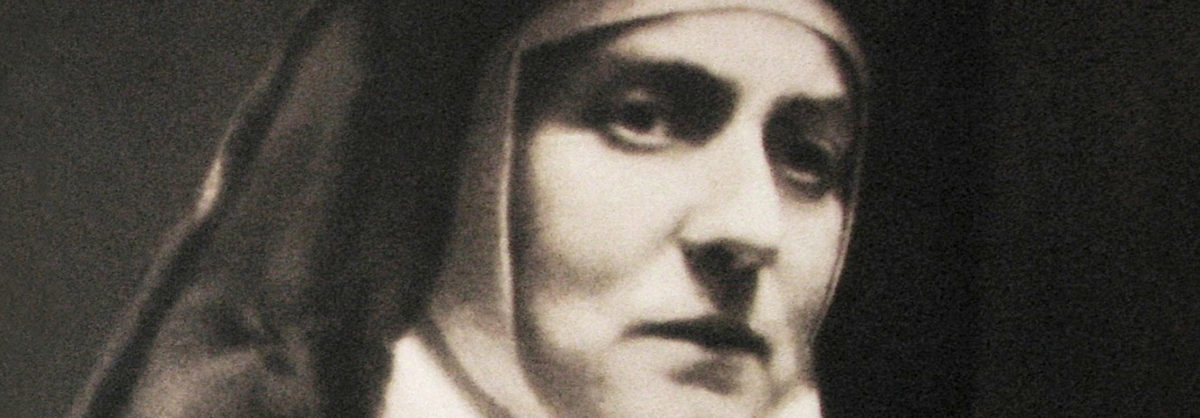We should all know the life of Edith Stein, a martyr of our age.
Also known as St. Teresa Benedicta of the Cross—one of six co-patron saints of Europe—Edith was born in 1891 in Breslau, Germany (modern-day Wroclaw, Poland). The youngest of eleven children, she was raised by her mother after her father’s untimely death. At fourteen she “consciously stopped praying” and rejected her Jewish faith, yet she retained a great desire for the truth, which manifested in her studies of psychology and then philosophy.
A brilliant student, Edith became assistant to the well-known philosopher, and fellow Jew, Edmund Husserl, and despite the fact that many doors in the academy were closed to her because she was a woman, she published scholarly works, contributions that are still valued today.
At the age of twenty-nine, moved by the courageous witness of a Christian friend who was unexpectedly widowed, and the writings of Teresa of Avila, Edith came into the Catholic Church. She spent the next decade writing and teaching before following her heart’s desire to enter the Carmelite convent in Cologne, Germany. Nine years after that, she perished in the gas chambers of Auschwitz, a victim of the Nazi pogrom against the Jews.
In 1998, John Paul II declared Edith a “martyr for love” because of the way that she had embraced her death. As if living a litany of self-offering, Edith repeatedly and consciously chose to immolate herself by uniting her suffering to Christ’s Cross for the salvation of her own people, the Jews.
At her religious profession in 1933, in the face of growing German anti-Semitism, Edith told her prioress, “Human action cannot help us, but only the sufferings of Christ. My aspiration is to share them.”
And five years later, when she was transferred for her safety to the Carmel in Echt, Holland, she gave a note to her new prioress:
“Dear Mother, I beg you, give me permission to offer myself to the Heart of Jesus as a [sacrifice] of atonement for the sake of true peace, that the Antichrist’s sway may be broken.”
Edith continuously renewed this offering of herself in the years that followed, even as the Nazis entered Holland.
When the nuns wanted to hide her, she was adamant: “Why should I be spared? Is it not right that I should gain no advantage from my Baptism? If I cannot share the lot of my brothers and sisters, my life, in a certain sense, is destroyed”
Shortly after this, she and her sister Rosa, who had also converted and come to stay in Echt, were collected by Nazi officers. “Come,” Edith said to her sister, “we are going for our people.”
Witnesses reported seeing her a few days later, shortly before she was herded into the gas chamber, moving among the frightened Jews—her people—consoling the frantic mothers, offering her hands to frightened children.
Despite the deeply dramatic quality of Edith’s final days, her witness speaks perhaps most eloquently in a quiet moment three years before she entered Carmel, as she was paying a visit to her mentor Edmund Husserl. She had converted and was living an intense life of study, work, and prayer, a happy life that she wished to share with Edmund. Yet even as Edith confided her joy to her friend, she could see that he was not open to it. After the meeting she wrote in her journal, “Every time I feel my powerlessness and inability to influence people directly, I become more keenly aware of the necessity of my own holocaust”
There, in the presence of the friend whose conversion she could not effect, Edith united herself with Christ, sinking her roots deeply into his salvific death. She recognized that the only thing to “do” in this moment was to offer herself, drawing Edmund into her personal prayer and suffering.
It was her holocaust before the Holocaust. It was the true form of Edith’s life, the self-offering that is the form of every saint’s life, the very same to which we are all called.
In Elizabeth Ann Seton’s life, this self-conscious self-offering was played out in circumstances less dramatic, yet no less intense. Like Edith, Elizabeth could not imagine her own salvation apart from that of those whom she loved. Her daily sufferings were folded into her pleading prayer.
We see this in the way Elizabeth lived her marriage, with a constant tender concern for her husband’s soul that reached a crescendo in the barren cold of the lazaretto, while they were quarantined during their trip to Italy, as she tended his ravaged body, all the while bearing his heart upwards with thoughts of heaven.
We see it in the way that Elizabeth entered the Catholic Church, with a relentless discernment for her children’s well-being, as alive to their salvation as to hers.
And we see it finally in the way that she embraced the mission to be a “mother of many daughters,” making the cares of the Sisters in the religious congregation she founded her own, teaching them how to live and finally how to die.
Like Edith, Elizabeth knew what it was to be in front of circumstances that cannot be changed, and yet to gather all one’s energies into self-offering and prayer.
The two women saints show us what it is to be a holocaust. They witness to this way of living and dying by uniting one’s energies to the ultimate sacrifice Christ accomplishes on the Cross.
As we face our own impossible circumstances, we might pray that their aspirations will be ours, their lives a pattern for our own.
LISA LICKONA, STL, is Assistant Professor of Systematic Theology at Saint Bernard’s School of Theology and Ministry in Rochester, New York, and a nationally-known speaker and writer. She is the mother of eight children.
This reflection was previously published. Click here to view all the Seton Reflections.
Image: St. Teresa Benedicta of the Cross passport photo, ca. 1938
